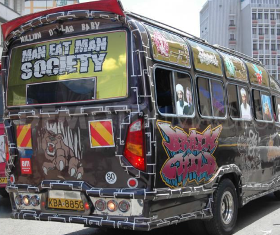By Eddah Oseko
Published November 6, 2013
 Travelling in a public service vehicle known as a matatu in Kenya can be a bag of mixed fortunes according to a new book titled Nairobi’s Matatu Men: Portrait of a Subculture. Running 256 pages, this book by Mbugua Wa Mungai, a lecturer at Kenyatta University in Nairobi, not only gives an in-depth analysis of what keeps the men who operate matatus going but also argues that to understand the matatu is to begin to understand Kenya.
Travelling in a public service vehicle known as a matatu in Kenya can be a bag of mixed fortunes according to a new book titled Nairobi’s Matatu Men: Portrait of a Subculture. Running 256 pages, this book by Mbugua Wa Mungai, a lecturer at Kenyatta University in Nairobi, not only gives an in-depth analysis of what keeps the men who operate matatus going but also argues that to understand the matatu is to begin to understand Kenya.
Wa Mungai, who specialises in popular culture, Kenyan urban folklore and disability in culture, tells a story of a sub-culture that has been iconic to Nairobi’s everyday life since the 1970s when Nairobi’s privately-owned mini buses came on the scene. The writer takes this culture as an entry point into a discussion of broad issues about Nairobi and Kenyan society.
A matatu man features prominently among the rank of the Kenya’s poor. To them, wa Mungai writes, everything is perceived as competition as they strive to escape the poverty they have been condemned to. They believe in getting rich or die trying.
Most drivers and conductors of matatus live in slum areas where they find life affordable. They are mostly school drop-outs who lack the skills for acquiring white collar jobs. They believe in getting rich or die trying. The road is their space and hence they can drive however they please. Most of the time they get into conflict with drivers of private vehicles because the latter are seen to be driving slowly and hence preventing the former from their chase for money. They feel insecure when they see a woman driving. To them, women are taking up men’s space; men are being suffocated.
Mbugua states that for a matatu man being a real man is cultivating the macho body. A matatu man is expected to dress in a particular way that is in sync with the youth. The youth refuse to board matatus that have conductors who are not smartly dressed arguing that they do not suit their taste. For a conductor who is willing to look macho ends up spending a lot of money on clothes. Conscious steps are taken in order to look cool. This is done to attract school girls who fall prey to the perceived image that a matatu man is rich from the fares they collect from passengers.
On entering a matatu, you find pictures on the windows that have naked women showing their breasts and buttocks. The women here are viewed as sex objects. Stickers are also put that have wordings that demean women e.g. men are like gold-too hard to find and men are like oxygen women cannot do without. These texts confer ‘price-less’ value on the male while the female is made to look cheap and non-essential.
Matatu men are faced with many challenges, leading to their uncouth behaviour in an attempt to cope. For violating traffic rules, they have to bribe the police in order to escape punishment. They then hike the fare so as to recover what they have lost to the police. They also face the problem of being car-jacked by thugs and pay a fee to the owners of the route they are operating on.
Most matatu crew members fall within the age bracket of 24 – 35 years. This is the age bracket of the youth in Kenya and forms the majority of citizens. They are mainly drawn from the Kikuyu and Kisii communities.
The matatu man’s occupation is a mirror for the future of a good number of Kenyan youth. They share a sense of marginalisation, just as they do their hopes and aspirations.
Matatu has been in operation in Kenya since 1953, first coming onto the scene in Nairobi as private taxies. The first matatu, an open-back pickup truck, was owned by a man from Narok. The fare was three cents to anyone who needed to make a quick trip to the city. They were branded private operators by the municipal by-laws.
The presence of the matatu was felt forcefully in 1973 after then President Jomo Kenyatta issued a decree allowing them to compete with buses.
The Michuki Rules of 2004 sought to streamline the matatu sector. The new regulations required matatu drivers and conductors to be issued with certificates of good conduct and be in uniform, all vehicles to be fitted with speed governors and seat belts and carrying of standing passengers was outlawed.
Matatu men seem aware of their indispensability within the Kenyan political economy. Kenyan government does not seem to have the resources to invest in a mass transit system that would enable standardized work procedures, whether it is in terms of crew’s work ethics or in terms of vehicles deign operations.
The sub-culture of the matatu men is so widely known and so deeply experienced that, in fact, the term “matatuism†meaning doing things the matatu way has been coined to describe the habit of deliberately refusing to play by the rules and doing things in an unpredictable fashion.
 Wa Mugai, whose doctoral dissertation at Hebrews University of Jerusalem in Israel in 2004 analysed identity politics in Nairobi’s matatu folklore, uses an easy writing style. The words are well selected and they hook the reader. After reading this book any person who boards a matatu can finally understand why matatu crew behave the way they do, where they have come from and where they are going.
Wa Mugai, whose doctoral dissertation at Hebrews University of Jerusalem in Israel in 2004 analysed identity politics in Nairobi’s matatu folklore, uses an easy writing style. The words are well selected and they hook the reader. After reading this book any person who boards a matatu can finally understand why matatu crew behave the way they do, where they have come from and where they are going.
Nairobi’s Matatu Men: Portrait of a Subculture is edited by Kimani Njogu and published by Goethe-Institut in collaboration with Native Intelligence, Twaweza Communications and Jomo Kenyatta Foundation in 2013. It costs Sh1,000 per copy.





Precisely what honestly moved u to post “The Sub-Culture of Nairobi’s Matatu Public Transport Crew
Explained | ArtMatters.Info� I personallyseriously enjoyed reading the
blog post! Thank you ,Sara